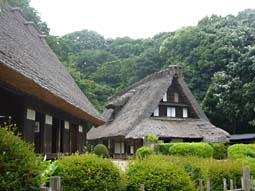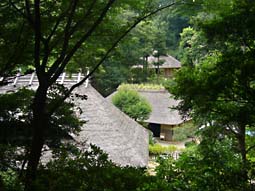 |
|
Here and There introduces art, artists, galleries and museums around Japan that non-Japanese readers and first-time visitors may find of particular interest. The writer claims no art expertise, just a subjective viewpoint acquired over many years' residence in Japan.
|
|
 |
|
|
 |
 |
National Treasures in the Great Outdoors:
Kawasaki's Open-Air Folk House Museum
Alan Gleason |
|
 |
|
 |
| Gassho-zukuri houses from the Hida region; Minka-en boasts four of these impressive structures. |
|
An up-valley view of some of the thatch-roofed houses in the Minka-en "village." |
Tourists from abroad have been known to journey deep into the mountains of central Japan -- a solid day's trek from either Tokyo or Osaka -- just to see the famous steep-sloped gassho-zukuri ("hands in prayer") thatched roofs of the Hida region. For visitors to Tokyo on a tight schedule, however, there is a highly satisfying local substitute: the Japan Open-Air Folk House Museum (Nihon Minka-en) just across the Tama River from Tokyo in Kawasaki.
The Minka-en has transported four very imposing gassho-zukuri specimens all the way from their native Hida and placed them in a lovely wooded valley in the Tama Hills. Aside from the lack of ten-foot winter snowdrifts, it could almost be Hida.
When the city of Kawasaki founded the Minka-en in 1965, at the height of Japan's postwar boom, its intent was to rescue a number of old local minka ("folk houses") from certain demolition. But the project took on a life of its own, and the park now boasts 25 exquisitely preserved farmhouses and other historical structures -- among them a rural Kabuki stage -- from all over Japan. Nestled in a long narrow valley, the buildings are arranged in a series of tiny hamlets. The illusion of being deep in the mountains is complete, yet you are only a few minutes' walk from the nearest suburban train station.
Were it not for the Minka-en's efforts, most of these architectural treasures would have been lost forever. The 18th-century Yamada farmhouse, for example -- one of the gassho-zukuri structures -- was the last remaining building in its village, which was abandoned to make way for a dam in the early 1970s.
 |
A guide sits by the irori hearth
inside one of the Minka-en open houses.
(Photos by Alan Gleason, courtesy of Nihon Minka-en.) |
All the houses at Minka-en are open in the sense that you can step inside as far as the dirt entryway floor. On any given day, however, only a few houses are designated as fully "open" to visitors willing to remove their shoes, climb onto the raised tatami floors, and explore the inner rooms. Identifying each of these open houses is a fire burning in the irori hearth and a staffperson on hand to stoke the fire and describe the history of the home and the lives of its inhabitants.
There is a practical reason for the fires; all of these houses must be periodically smoked to prevent rot and infestation with insects. Thanks to this practice, the aroma of woodsmoke is a constant companion as you stroll through the park. There's no better place to take a break from Tokyo and pretend that you're actually hundreds of miles -- or years -- away.
|
|
|
 |
 |
|
 |
Japan Open-Air Folk House Museum (Nihon Minka-en) |
 |
|
 |
7-1-1 Masugata, Tama-ku, Kawasaki City, Kanagawa Prefecture |
|
Phone: 044-922-2181
Open 9:30-5:00 (-4:30, November-February); admission until 4:30 (Closed Monday, the day after national holidays, and December 28 - January 4)
Transportation: 17 minutes walk from Mukogaoka-Yuen station on the Odakyu Line (30 minutes southwest of Shinjuku) |
 |
|
|
 |
 |
Alan Gleason
Alan Gleason is a translator, editor and writer based in Tokyo, where he has lived for 24 years. In addition to writing about the Japanese art scene he has edited and translated works on Japanese theater (from kabuki to the avant-garde) and music (both traditional and contemporary). |
|
|
|
 |
 |
|